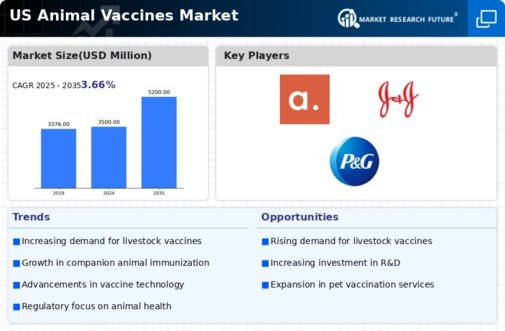Rising Pet Ownership Rates
The increasing trend of pet ownership in the United States appears to be a significant driver for the animal vaccines market. As more households adopt pets, the demand for veterinary services, including vaccinations, is likely to rise. According to recent statistics, approximately 67% of U.S. households own a pet, which translates to over 85 million families. This growing pet population necessitates a robust vaccination schedule to ensure the health and well-being of animals. Consequently, the animal vaccines market is expected to expand as pet owners become more aware of the importance of preventive healthcare. Furthermore, the willingness of pet owners to invest in their pets' health may lead to increased spending on vaccines, thereby propelling market growth in the coming years.
Advancements in Vaccine Technology
Innovations in vaccine technology are poised to transform the animal vaccines market. The development of novel vaccine formulations, such as recombinant and mRNA vaccines, may enhance efficacy and safety profiles. These advancements could lead to more effective immunization strategies against various diseases affecting livestock and pets. For instance, the introduction of mRNA technology, which has shown promise in human medicine, might be adapted for veterinary use, potentially revolutionizing the way vaccines are produced and administered. As a result, the animal vaccines market may witness a surge in demand for these advanced products, reflecting a shift towards more sophisticated and effective vaccination solutions.
Growing Demand for Livestock Vaccination
The rising demand for livestock vaccination is a crucial factor influencing the animal vaccines market. As the global population continues to grow, the need for increased food production becomes more pressing. Vaccination plays a vital role in maintaining the health of livestock, ensuring productivity, and preventing disease outbreaks that could affect food supply chains. In the U.S., the livestock sector is a significant contributor to the economy, with the market for livestock vaccines projected to reach approximately $2 billion by 2026. This demand for effective vaccination solutions is likely to drive innovation and investment in the animal vaccines market, as producers seek to enhance herd immunity and overall animal health.
Increased Awareness of Zoonotic Diseases
The heightened awareness of zoonotic diseases, which can be transmitted from animals to humans, is likely to drive the animal vaccines market. Public health campaigns and educational initiatives have underscored the importance of vaccinating pets and livestock to prevent outbreaks of diseases such as rabies and avian influenza. This awareness may lead to increased vaccination rates among both companion animals and agricultural livestock, thereby fostering growth in the animal vaccines market. Moreover, the potential economic impact of zoonotic diseases on public health systems could further incentivize investments in vaccination programs, ultimately benefiting the market.
Regulatory Support for Vaccine Development
Regulatory frameworks that support vaccine development are essential for the growth of the animal vaccines market. In the U.S., agencies such as the USDA and FDA play a pivotal role in ensuring the safety and efficacy of veterinary vaccines. Streamlined approval processes and incentives for research and development can encourage pharmaceutical companies to invest in new vaccine technologies. This regulatory support may lead to a more dynamic market environment, fostering innovation and the introduction of new products. As a result, the animal vaccines market could experience accelerated growth, driven by a robust pipeline of new vaccines that meet the evolving needs of veterinarians and animal owners.














Leave a Comment